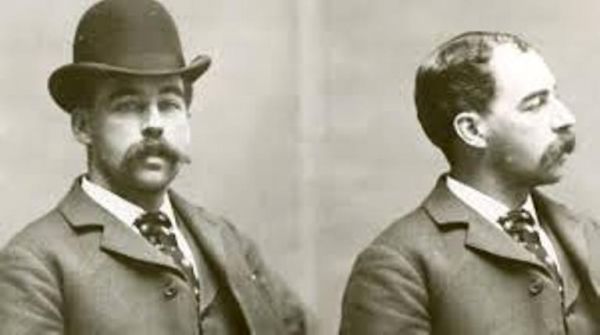
H.H. Holmes
“Come
with me, if you will, to a tiny, quiet, New England village, nestling
among the picturesquely rugged hills of New Hampshire.”
-H.H. Holmes, “Holmes’ Own Story," 1895
So begins, in his own words, the story of H.H. Holmes, America’s first
known – and perhaps most prolific – serial killer. Born Herman Webster
Mudgett in 1861 and raised by his parents against the bucolic backdrop
of Gilmanton, New Hampshire, he had a privileged upbringing. A youth of
high intelligence, Herman excelled in school. He exhibited a hallmark of
many serial killers in their youths, the torture and killing of
animals. Despite this, young Herman managed to stay out of trouble,
though he was bullied by peers. During one such experience, his
schoolmates dragged him inside the office of the town's doctor, knowing
he was afraid of it. There he faced the doctor’s model skeleton. Though
terrified at first, he later claimed the incident imbued in him a desire
to learn about human anatomy.
DEVIL AS DOCTOR
Learn about anatomy he did. Mudgett enrolled at the medical school of
the University of Michigan. It was there that he discovered a passion
for dissecting cadavers. For Mudgett, medical school was an education in
how to profit from acquiring and selling cadavers and skeletons. He
learned that human skeletons were a commodity for which people paid
handsomely. Additionally, he gleaned a trick of his lifelong career as a
con artist: insurance fraud. Mudgett purchased claims on fictitious
people and subsequently disfigured cadavers, using them to cash in on
the policy of the “accident victims.” Not even a year after he began
studying medicine, the school expelled Mudgett for stealing cadavers. He
was readmitted that same year. Such was the life of this charismatic
hustler: rarely was he unable to smooth talk people so that things went
his way.
At age 23, Herman Mudgett graduated from medical
school. After approximately a year of drifting, he decided to move to
Chicago. He also took on the name that would be recorded in the annals
of criminal history: Henry Howard (H.H) Holmes.
Holmes arrived in
Chicago in May of 1886. He settled in Englewood, then a commercially
robust suburb on the city’s south side. There he began work as a
pharmacist in a drugstore owned by the Holton family. Pharmacy owner
Edward Holton died several months later, reportedly of cancer. Holmes
convinced Holton’s widow to sell him the store. After an initial down
payment, Holmes stalled any further payments to the widow, who
eventually filed suit against him. Shortly afterward, she mysteriously
disappeared, most likely dying by Holmes' hand.
World's Columbian Exposition (Chicago World's Fair), 1893
At
that time, circumstances in late 1880s Chicago and the nefarious
schemes and blood lust of Holmes joined to create a perfect storm for
serial murder. Chicago was in a period of growth and renewal. The city
was rebuilding after the great fire of 1871, which burnt most of its
business district to ashes and left 100,000 residents homeless. Business
and real estate development were welcomed. People seeking jobs flocked
to the city. Soon, the World’s Columbian Exposition, also known as the
Chicago World’s Fair, would bring 26 million visitors to the city.
"The Castle" of H.H. Holmes
The
ground floor of Holmes' twisted masterpiece was divided into ordinary
retail spaces, including a jewelry store, pharmacy, blacksmith shop,
barber and restaurant. The third floor consisted of apartments, offices
and Holmes’ living quarters. It was the second floor and basement of the
structure that belied his monstrous plans. The second floor was a
labyrinthine puzzle of windowless rooms, stairs and doors that led
nowhere, false partitions, trap doors and secret passageways. There was a
greased chute that led directly to the basement. Some rooms were
soundproof and had peepholes enabling Holmes to monitor their interiors.
Pipes were built in that were connected to a gas line, the flow of
which Holmes could control from his master suite. He asphyxiated victims
with the gas. Holmes spent many a deranged hour in the basement. It was
equipped with a crematorium, vats of acid, a dissection table, surgical
implements and pits of quicklime capable of disintegrating a human body
within hours. There was also a torture device that stretched live human
bodies apart from both ends until death.

A
man named Benjamin Pitezel arrived in Chicago to answer an ad Holmes
placed in search of carpenters. Pitezel was a petty criminal and
alcoholic who, to his credit, was devoted to his wife Carrie and five
children enough to be constantly drifting in search of employment to
support them. Holmes took a liking to Pitezel, eventually using him as
an assistant in his fraudulent activities and cons.
Once
construction on Holmes’ house of horrors was complete, he was able to
become the efficient killing machine of his fantasies. Holmes killed
countless victims, mostly women. Many were in his employ at the
commercial spaces of the castle. Some were his mistresses. One such
unlucky woman, Julia Conner, came to live and work in the castle with
her husband and eight-year-old daughter Pearl. Julia began an affair
with Holmes, and when her husband demanded that it stop, she refused and
her husband left town. Holmes eventually killed Julia and Pearl when
Julia became pregnant by him and demanded marriage. As Holmes often did
with his kills, he cleaned Julia’s skeleton and sold it to a local
medical school for $200.
To best take advantage of Chicago’s
influx of tourists during the world’s fair, Holmes advertised in the
paper. In these ads, he called the castle, which was only a few miles
away from the fairgrounds, the “World’s Fair Hotel.” Holmes not only
ensnared soon-to-be victims by newspaper ad, but he also attended the
fair in the company of the Pitezel children. There, the impeccably
dressed doctor would turn on the charm, luring wealthy women to his
castle with the promise of a good night’s rest. These female fairgoers
were perfect choices as prey. Usually from out of town and unnoticed in
the huge fair crowds, they were impossible to trace once they vanished
into the castle's dark recesses. Holmes kept killing, kept perpetrating
frauds, kept selling skeletons and above all, he kept getting away with
it.
THE DOWNFALL
Once the fair ended in the
fall of 1893, business was no longer booming, and Chicago's bright
financial picture dimmed. Additionally, a problem was developing for
Holmes in the form of Benjamin Pitezel, whose alcoholism grew worse.
Holmes was acutely aware that Pitezel knew far too much about his
illegal activities. Deciding that Pitezel was no longer a benefit, he
planned to kill him and devised a way to make money at the same time.
Holmes told Pitezel and his wife that he needed their help to pull off
an insurance fraud. The plan was for Pitezel to take out a large policy
on his life, listing his wife as the beneficiary. Holmes would then
produce a cadaver and claim that it was Pitezel’s body, and they would
split the insurance payoff. Pitezel took out a policy with Fidelity
Mutual Life Association in Philadelphia, and Holmes persuaded Pitezel to
travel to Philadelphia with him to establish a presence there.

In
November of 1893, Holmes and Pitezel set off on a trip by train. For
months they traveled the country, swindling whoever would fall for their
scams. But when they arrived in St. Louis in July of 1894, their luck
ran out. For the first time ever, Holmes was arrested for attempting to
defraud a St. Louis pharmacy owner. He was put in a jail cell with a
notorious train robber named Marion Hedgepeth. Perhaps in an attempt to
brag to Hedgepeth about his criminal acumen, Holmes told him of the
insurance scam he planned to commit in Philadelphia. Holmes promised
Hedgepeth $500 if he’d recommend a crooked attorney he could use to
facilitate the fraud. Hedgepeth gave Holmes the name of an attorney,
whom Holmes contacted once he was out of jail.
Several weeks
later, Holmes and Pitezel arrived in Philadelphia. They rented a
storefront and Pitezel used it to pose as a patent dealer. But instead
of following through with the plan, Holmes killed his partner with
chloroform and burned his face, setting up the scene to look like a
chemical laboratory explosion. Some time later, an inventor walked in to
the office to talk patents with Pitezel and discovered his body.

Because
the body had to be identified by a family member for the insurance
company to pay out, Holmes showed up on the scene with fifteen-year-old
Alice Pitezel and they identified the body. The attorney that Hedgepeth
recommended to Holmes in jail was also used in the transaction. The
insurance company paid the money to Carrie Pitezel. Holmes met with her
and was able to talk her out of most of the money and two more of her
children, under the guise of later meeting up with their father. Holmes
took off with Alice, Nellie, and Howard Pitezel, traveling for weeks.
Yet Holmes made the critical error of not sending Hedgepeth the $500 he
had promised him in jail. As payback, Hedgepeth sent a letter to the
insurance company, detailing Holmes’ scam. The insurance company hired
the famously thorough Pinkerton Detective agency to track Holmes. On
November 16, 1894, Holmes was caught in Boston and arrested, just before
fleeing the country by ship. At first he was only charged with
insurance fraud; later, he was charged with the murder of Benjamin
Pitezel. Holmes was transferred to a prison in Philadelphia to stand
trial. A bereft Carrie Pitezel was charged with conspiracy. Holmes told
one lie after another when authorities demanded to know where her three
children were. Eventually, investigator Frank Geyer, after a lengthy
international search, was able to determine that Holmes had killed all
three Pitezel children. The bodies of Nellie and Alice were found buried
in the cellar of a home in Toronto, and Howard’s charred bone fragments
were found in a stove in Indianapolis. After the fates of the murdered
children were discovered and the authorities searched the castle, the
level of Holmes' depravity was revealed.

After
a trial in which he acted as his own attorney, Holmes was sentenced to
death for the murder of Benjamin Pitezel. Though he was prosecuted for
only one death, estimates of his murder count range from 20 to 200.
Holmes was executed by hanging on May 7, 1896. Yet the horrific tale of
the monster and his castle never died; it remains in popular culture as
the subject of books, documentaries and an upcoming feature film.
"Yes
I was born with the devil in me. I was born with the evil standing as
my sponsor beside the bed where I was ushered into the world, and he has
been with me since."
–From "Confession of H.H.Holmes," printed in Philadelphia North American, April 11, 1896





















